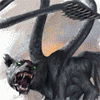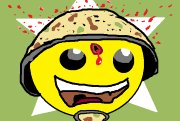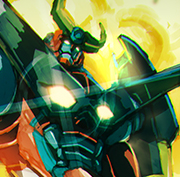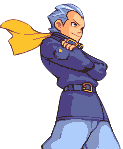|
I ran a reskinned dragon against my party a few sessions back - basically a Medium Black Dragon with "acid" changed to "poison" in order to make it a giant snake monster. My initial impression is that a black dragon is a pretty busy monster on paper. Between dragon breath, draconic grace, escalator, and a random ability, this dragon had a hell of a lot going on. All inall, though, it's not as bad as all that to manage in practice. If you have a particularly complex dragon I do recommend highlighting the parts that truly separate it from a lesser monster, such as a blue dragon's counterspell ability, because that's the sort of thing that might get overlooked. As far as their difficulty, I took one of our party down without too much difficulty and severely threatened the rest of the party but they pulled through. The dragons in this game are definitely monsters that you feel like worked hard to defeat.
|
|
|
|

|
| # ? Jun 7, 2024 19:15 |
|
CaptCommy posted:Using the setting in book, with maybe some minor adjustments. You'll probably be the last spot for now, just so this doesn't get too insane, since we're now looking at potentially eight players. Doesn't bother me though, I've done big groups before. As above, email me to get in on the discussion. Thanks, I'll email you this evening when I'm at my home computer.
|
|
|
|
Does anyone have any links on how to convert monsters from Pathfinder or 4 edition to 13th Age? I'm going to pre-order the Bestiary but I want to throw my players something uniqueish at them for a bit.
|
|
|
|
Undead Unicorn posted:Does anyone have any links on how to convert monsters from Pathfinder or 4 edition to 13th Age? I'm going to pre-order the Bestiary but I want to throw my players something uniqueish at them for a bit. So far I've just picked something of x level that looked kind of close to what I wanted, changed the name, and called it good.
|
|
|
|
... Quick question. The character creation gives you some stats that you calculate via "add these three stats and get the median". Would I be correct that what they pretty much mean is to divide by three and round up? At least, that's what I got from the character creation example, and its how I've been doing it.
|
|
|
|
Kerzoro posted:... Quick question. The character creation gives you some stats that you calculate via "add these three stats and get the median". Would I be correct that what they pretty much mean is to divide by three and round up? At least, that's what I got from the character creation example, and its how I've been doing it. Nah, you literally arrange the three stats in order from smallest to largest and take the middle. No averaging.
|
|
|
|
No. You look at the three stat bonuses, pick the one that lies in the middle, and use that. For example, look at calculating AC. It doesn't say "add these three stats and find the median." It says "find the middle value among your Con modifier, Dex modifier, and Wis modifier."
|
|
|
|
Undead Unicorn posted:Does anyone have any links on how to convert monsters from Pathfinder or 4 edition to 13th Age? I'm going to pre-order the Bestiary but I want to throw my players something uniqueish at them for a bit. What Pvt.Scott said is very applicable. If you want to take it a step further, pour over the DIY Monster tables found at the back of the monster section. It's not hard to convert monsters in this system. You can re-skin many of 4e's movement-based powers as having a monster pop-free, or engage a player as a result of their attack. You can safely convert things like Reflex, Will, or Fortitude saves as effects that trigger from "Natural roll above stat" or targeting MD/PD as seems applicable. Also, feel free to pick and choose applicable abilities from different monsters in the book as you like. Completely ignore CR. Just make the monster an appropriate level for your party per the encounter building guidelines. The most important thing is to simplify the monster significantly. Things like "Melee bite +24 (2d6+12), 2 claws +23 (1d8+8), 2 wings +18 (1d6+4), tail slap +18 (1d8+12)" may be well and good for Pathfinder, but 13th Age would prefer something more like "Vicious bite- +20 vs AC, 18 damage. Natural even hit, target takes 10 ongoing damage, save ends.", and giving the monster about half the attacks in general. That being said, you'll probably find a lot of what you're looking for in the Bestiary. There's a lot of content there; I can't think of too many notable monsters off the top of my head that were completely overlooked.
|
|
|
Kerzoro posted:... Quick question. The character creation gives you some stats that you calculate via "add these three stats and get the median". Would I be correct that what they pretty much mean is to divide by three and round up? At least, that's what I got from the character creation example, and its how I've been doing it. You're thinking of the Mean. As the others have said, the Median is the middle value. (The Mode is the most common value, and now you know literally everything they taught me in 7th grade math, what a waste of time that was)
|
|
|
|
|
Thank you both for the advice, it's good to know just how easy it is to port monsters and stuff over. I have another question. I like supporting my local game store, can I pre order the Bestiary from it and get the pdf? Or is that an online store thingie only?
|
|
|
|
So there's been an interesting discussion going on in the Next thread, part of which involves the 13th Age Fighter and Cleric. I'd love to get talked to about the Fighter, since I'm about to start running a campaign. No one is playing one, but it is underpowered compared to other classes? I've paid more attention to the non-class stuff so far since I'm going to be the GM.
|
|
|
|
Yeah. It and the Paladin are pretty 'weak classes'. Admittedly balance is a lot better in this game then say 3.5 or most OGL games, but it's far from perfect and not as good as 4E.
|
|
|
|
Indeed it isn't. How might people go about fixing it? Something else I've noticed is that, given the small number of talents each class gets at Adventurer tier, each one that picks a given talent will end up picking up its feats too, since they have nothing else to spend them on. Hopefully 13TW will fix that problem somewhat, but I can't help thinking that 13A ends up making classes more like cookie-cutters than 4E's detractors claim that 4E does.
|
|
|
|
UrbanLabyrinth posted:Indeed it isn't. How might people go about fixing it? There is a legitimately great homebrew Paladin somewhere on the Pelgrane forums right now. As for the fighter, I'm trying to write up a 'Knight' varaint based on 4e that is just designed to actually tank and punish enemies for tackling other characters or dish out damage.
|
|
|
|
I guess I missed the part how fighter (and apparently paladin, though I can definitely see that one) is notably worse than other similar classes. Can one of you break down how that works out?
|
|
|
|
Copied from the Next thread.Quadratic_Wizard posted:First, 13th Age. In the game, a characterís Class gives them access to some core stats like HP and base defenses, class features that every member of the class gets, class talents that let you customize your character at first level, and then maybe something special like the fighterís maneuvers or the clericís spellcasting. Letís go one by one through these.
|
|
|
|
I saw it, yes. I agree with part of his general conclusion (the normal casters are still very much strong, their daily options are especially fantastic compared to the mundanes') but not his reasons (not gonna quote-snipe that whole thing but strength domain isn't all that and a bag of chips because clerics are usually better off casting one of those big fuckoff spells he mentions later, threatening and heal aren't really trying to do the same thing) and those don't really tell me anything about it as a whole, just compared to the admittedly-strong cleric and only very specific cherry-picked options. I'm asking for a similar analysis between more comparable classes, because fighter seems to be singled out as weak even among those.
|
|
|
|
One possible fix I could see for the Fighter would be to make it more sticky. It already has Threatening, but Threatening is a bit anemic compared to 4e's main defender mechanic. One way to make it more punishing on enemies trying to disengage from the Fighter would be to have the Fighter deal Constitution or Dexterity modifier damage on the enemy even if they managed to disengage, which combined with the Adventurer feat would turn trying to disengage from the Fighter into a situation where the enemy is hosed either way if they try to disengage from the Fighter. On top of that I'd just take a leaf from 4e and allow the Fighter to stop enemy movement with opportunity attacks. Enemies always have the option of provoking opportunity attacks from the Fighter without having to make a disengage check, and to counteract that I'd give the Fighter's opportunity attacks a bit more punch. Something as simple as getting to add the better of your Constitution or Dexterity modifier on opportunity attacks provoked by enemy movement and if the attack hits the enemy stops in their tracks and is now engaged with you. However, this only goes so far into fixing the disparity between Fighters and casters: I've yet to play the game, but on paper it seems that while it's not quite as bad as in 3.5 or Pathfinder, Fighters and Paladins are still playing a completely different game from Wizards and Clerics in 13th Age. The real problem isn't just the fact that the Fighter may or may not be as good in combat as Wizards and Clerics, it's also the fact that outside of combat Fighters don't have as many possible venues of interaction as spellcasters. Outside of combat, the rules only have backgrounds and icons by way of support for the Fighter, whereas Wizards have backgrounds, icons, utility spells, cantrips, ritual magic and what-have-you. What the Fighter and Paladin could definitely use is more out-of-combat support. I understand why the designers of the game went for a mix of 3.5/4e elements for spellcasters, because they obviously love both of those games and wanted to mix the best of both worlds for that part of the system, but the non-spellcasting classes could definitely use more in the way of support outside of combat. EDIT: I'd look at the Rogue's Thievery as a starting point for giving Fighters something more outside of combat. This is a bit silly from here on, but all Fighters get a free background at +5 called Swole, which would be relevant to feats and demonstrations of strength, knowledge of where to best punch things, as well as impressing people by flexing your muscles and being the baddest motherfucker around. Give it feat support to allow for more out-there uses of Swole, all the way until Epic where you could use Swole to break the laws of physics (and I mean that in the physical sense: you grab the laws of physics in a headlock and break their neck), wrestle with abstract concepts (this is straight from Norse legend: in one of the Norse sagas Thor actually physically wrestles with Old Age) and be able to punch people in the face with a look. I know it's terribly silly, but something like that by way of out of combat interaction for Fighters would give them a bit of the free-wheeling narrative power that spellcasters currently have a monopoly on. Ratpick fucked around with this message at 09:49 on Oct 18, 2013 |
|
|
|
Might as well post this here, but a while back I was in a 13th Age game and had the crazy urge to go through, analyze each class, and balance them all in one frantic day. The Fighter was the most work, because I went with rewriting all of the flexible attacks, including the way they worked, making some of them 1/battle and having only 2 triggers, but also making sure that each one was competitive with the stuff other classes were getting at the same level. Paladin is really close to the Cleric, so it wasn't that hard. Just give the Paladin 4 more talents and a few extra uses of smite. Rogue needed a rewrite of the Momentum mechanic so that it didn't get worse the higher in level you went. For the Ranger, I went with the 5e style and changed Favored Enemy into the "I either hunt lots of little dudes or really big monsters", ie new Monster Hunter and Bounty Hunter talents. Then, made it so you can pick two of the double and hunter talents or an animal companion, and then two extra normal talents. The rest of the classes were all surprisingly well balanced when using the Cleric as a baseline. The whole thing is here. https://docs.google.com/document/d/1lJ4XVKdGDv8dhrssM_7V5niO8JxCpvm-BeSsFejitXA/edit
|
|
|
|
How obvious is the power differential to new players? I've run 4e and 3e games before as a DM with a variety of skill sets, but never with a totally new group - I've got a fighter and a barbarian joining soon to go with my sorc, rouge and cleric, and I'm a little worried about the power differential being obvious. My simple change to the barbarian was to add status effects to the attacks made while 'roid raging, similar to the sorc's random extras when gathering power. Consequently, I've added a random table giving dazed, ongoing, weakened and stuck at various levels on a d12. It doesn't seem like it will magically become overpowered, but the barbarian just seems a little too simple and non-interactive. Anyway, I should probably say something about how my boltstrike game actually went: the characters: A wandering genius alchemist (reskinned cleric) who was cast out of the strict guild for experimenting and seducing the daughter of the chief alchemist (I had no idea intra-guild politics were going to be a big thing in the campaign, but they apparently are), with backgrounds in Doctoring (+2), Begging (+1) and McGyvering (+5) Sorceror hailing from a wild and distant tribe who has the ability to sense leylines. Is very much the raised-by-wolves/Space Wolf stereotype, but seems like it could be fun. Backgrounds in Animal Empathy (+4) and Wiry Atheleticism (+4). The same character this player always plays - a "sexy" half gnome half halfling ("The only quarterling on the planet) rogue who is quick with her daggers and quicker with her foul mouth. Backgrounds in Thievery (+4), smoothtalking (+2) and "failed burlesque dancer" as a negative background (player's idea) at -4. They're recruited to check out an imbalance of magical energy from one of the Empire's warding towers to the south of Axis, in a fairly "fetch quest" manner. Rolling relationships, there's two sixes with the High Druid and a five with the prince of shadows. I'm still a little unsure as to the best ways to use 6's - fives I like to take control of the story a little bit by exchanging boon for request, or giving short term benefit to long term gain, but in the case of 6's, I'm a little free with it - let the players cash them in for anything they can convince me of. After a little bit of an introduction session as they amble down the road on, variously, a horse, a cart and a medium sized dog, they spot a tinker's caravan rushing towards them. A fight immediately breaks out between rogue and alchemist over who gets the various pots, pans and alembics that leads to daggers drawn and an ambush by goblins allied with the Diabolist. I think I've been fairly sneaky in getting them in trouble in their first fight, until the sorceror punches his burning hands into a mook and a shaman, crits on both, piles of ash remain. Arriving at boltstrike in a timely fashion to find it's a sanctuary of the high druid, loosely allied with the empire in a fight of convenience against the nearby hellhole, but the leylines forming the wards are flailing loosely around the tower - somethings going on! With that awesome concept in place, the players proceed to ignore it completely. A 6 with the high druid is used to retroactively make Boltstrike a "magical herb garden for worship of nature itself". Another 6 is used to convince the high druid to convince the commander of the tower (this is done with calling a boon to shape trees into the words "CALL MEETING") to convene a meeting so that the blessing of nature may be passed onto the assembled garrison of wood elves. As a three, they spend the rest of the session taking the piss out of elves and scouring the tower for rare herbs to make into valuable potions. A combination of light show from the sorceror, an extremely un-sexy "the elves are horrified, but they can't look away!" from the rogue and a mcgyvered "flying distraction contraption" allow the amassing of a veritable horde of herbs and mosses, a couple of purloined magic items and a "political prisoner" of the high druid being stacked onto a cart and ridden off into the distance. After reminding them of obligations from the high druid and the empire, the universal response is "gently caress elves, let's go deal with this hellhole". And thus was the end of the Boltstrike pillar debacle. The tower was destroyed off camera while they were kicking in the door of a hellhole and getting shouted at by a demon matriarch for lacking basic courtesy - "This may be a hole into the demon underworld of hell itself, but we still knock, you rude bastards!" edit: added my favorite bit which I'd forgotten lenoon fucked around with this message at 15:03 on Oct 18, 2013 |
|
|
|
I think my problem with the barbarian is that it's simple to a fault. It's boring. There are only two tactical choices. "Who do I attacks" and "Should I start raging." And if they're either already raging or already used their daily rage, their only thing is "Who should I attack?" At least rangers get things like multiple attacks and the ability to take spells from other spell casting classes. EDIT: It also doesn't have the defenses or HP to tank a big hit like you'd think a roid raging class might.
|
|
|
|
One extra bit of stickiness that gets overlooked is the general intercept rule. If you move past someone not engaged, they have the option to engage you and end your movement (p. 164). I don't think it's quite enough to really get the feel of the 4e fighter, but it does help any of the beefy classes tank a bit more. Edit: One thing I think worth mentioning is that while the fighter certainly needs a small boost, it's not super obvious in play. Both fighters I've had in my games have enjoyed their play as much as anyone else. But I'm also super generous with my background applicability to even out narrative control some. CaptCommy fucked around with this message at 15:12 on Oct 18, 2013 |
|
|
|
Thanks for the replies! ... Looks like I have some editing to do for my defenses.
|
|
|
|
CaptCommy posted:One extra bit of stickiness that gets overlooked is the general intercept rule. If you move past someone not engaged, they have the option to engage you and end your movement (p. 164). I don't think it's quite enough to really get the feel of the 4e fighter, but it does help any of the beefy classes tank a bit more. It does help. Part of the reason I bring this up is that I'm playing one in one game and running a party that has one in another, and neither feel particularly underpowered or anything - I guess that's partially a function of how "worse" is a very, very relative thing compared to something like 3.5 and partially that quadratic wizardry (more and better dailies, etc) will kick in much harder at later levels.
|
|
|
|
My current barbarian house rules are to bump its damage die one size (two handers absolutely should be a d12) and increase its base hp (before multiplication) a few points. I like them being easy to hit sacks of HP. Still working out some ideas on the complexity side of things, but it's not terrible as is. My fights tend to go so fast that the barbarian player doesn't seem to mind. Tries to find a cool stunt or two to mix in and it works out alright. Would love some good talents to increase options though.
|
|
|
|
I was under the impression that the barbarian was already effective, if a tad boring? I mean I'm fairly sure the idea was to keep them swingy with poo poo like Unstoppable and Barbarian Cleave keeping you afloat instead of having a giant HP buffer, and they're not even that bad on the max HP front anyway. Some talents that have a bit more to them would be appreciated though.
|
|
|
|
01011001 posted:I was under the impression that the barbarian was already effective, if a tad boring? I mean I'm fairly sure the idea was to keep them swingy with poo poo like Unstoppable and Barbarian Cleave keeping you afloat instead of having a giant HP buffer, and they're not even that bad on the max HP front anyway. Some talents that have a bit more to them would be appreciated though. Oh it's totally effective, my player was just sad his barb didn't get a d12 anymore compared to the 4e version, and it's not a huge power swing. I should have clarified my house rules are typically campaign specific as I really like make small adjustments as a season to taste kind of thing. It's not at all a needed fix
|
|
|
|
The Fighter occupies an unfortunate bit of conceptual territory in that it is the "I hit dudez with a sword" class. Well guess what? So do a lot of other people and those who don't are talking to gods or telling physics to sit down and shut up. 4E had the advantage of a tactical game for the Fighter to dominate, but 13th Age doesn't. That puts it in a very small box indeed. While I have yet to have a Fighter player be bored with the class, I've thought about my own workarounds as well. One would be to merge the Fighter with the similarly-m'eh (at least to me) Ranger to maximize the interesting options in one class. It might also be worth allowing a Fighter to execute multiple flexible attacks off a single roll.
RyvenCedrylle fucked around with this message at 18:13 on Oct 18, 2013 |
|
|
|
CaptCommy posted:One extra bit of stickiness that gets overlooked is the general intercept rule. If you move past someone not engaged, they have the option to engage you and end your movement (p. 164). I don't think it's quite enough to really get the feel of the 4e fighter, but it does help any of the beefy classes tank a bit more. The thing about the fighter is that even though he's not boring to play, he doesn't really DO much. Flexible Attacks like Deadly Assault or Brace For It will fail to do anything 90% or more of the time, but when you use them, you're saying "I use Deadly Assault!" and it FEELS like you're doing something. It's the illusion of competence.
|
|
|
|
I usually find myself wondering why the Fighter, Ranger, Rogue, and Paladin aren't all just rolled up into one big pile of awesome poo poo as a single class and then I remember why. D&D.
|
|
|
|
Bring back, "Man at Arms," huh. I can get behind that.
|
|
|
|
|
S.J. posted:I usually find myself wondering why the Fighter, Ranger, Rogue, and Paladin aren't all just rolled up into one big pile of awesome poo poo as a single class and then I remember why. D&D. Well, the class would be a little too broad to cover ranged, melee, pet, sneaky stabby and tank. Maybe two classes.
|
|
|
|
Quadratic_Wizard posted:Might as well post this here, but a while back I was in a 13th Age game and had the crazy urge to go through, analyze each class, and balance them all in one frantic day. Huh, I really enjoyed reading through this. It looks like the other classes honestly weren't that far off in terms of power level, generally speaking, and it's nice to see all this information presented in one place fairly succinctly. I think I might use some of this later on if my campaign takes off. Pvt.Scott posted:Well, the class would be a little too broad to cover ranged, melee, pet, sneaky stabby and tank. Maybe two classes. That would be fine. Although you could easily make an argument for any of those class concepts to be paired with the other. However, I still really hate the Paladin as a concept when a Cleric exists side by side with it. I feel like the Paladin concept is too easily rolled into the Cleric, and then that leaves you with Fighter/Ranger/Rogue which I think are much easier concepts to put into a single class. S.J. fucked around with this message at 22:17 on Oct 18, 2013 |
|
|
|
Quadratic_Wizard posted:Might as well post this here, but a while back I was in a 13th Age game and had the crazy urge to go through, analyze each class, and balance them all in one frantic day. Wait how long ago did you write this? That isn't what strong recovery or strength domain do and you used that for the basis of a lot of your comparisons.
|
|
|
|
Strong Recovery lets you reroll a few dice when you use Recoveries, Strength Domain lets you upgrade your damage die one size and boost crits. They aren't 1:1 things, but approximations.
|
|
|
|
S.J. posted:Huh, I really enjoyed reading through this. It looks like the other classes honestly weren't that far off in terms of power level, generally speaking Yeah, once again alot more balanced then 3.5, but not as balanced or tactical as 4E. It looks pretty easy to fix a lot of the classes though.
|
|
|
|
Undead Unicorn posted:Yeah, once again alot more balanced then 3.5, but not as balanced or tactical as 4E. It looks pretty easy to fix a lot of the classes though. Disagree. Lots more balanced than 4e. Because 4e goes with character optimization as a minigame. The gap between first timer building his fighter out of the player's hand book and one using a polearm momentum or whatever bullshit build is huge, bigger than the gap between fighter and cleric.
|
|
|
|
Quadratic_Wizard posted:Strong Recovery lets you reroll a few dice when you use Recoveries, Strength Domain lets you upgrade your damage die one size and boost crits. They aren't 1:1 things, but approximations. Ah, I missed the top of line of strength domain.
|
|
|
|
A guy on the Google+ group made his own character sheet, and he included some ability sheets that I thought were really nifty, but his had a few minor issues (fuzzy text, needed a few more features). I went ahead and spent the afternoon teaching myself Scribus and whipped these up. Let me know if anything needs modified. I'm considering doing a 6-ability per page version for people who want more room to write and don't mind as many pieces of paper. Class Features & Talents Flexible Attacks Powers & Spells Edit: Just out of curiosity, and because I don't have everything memorized, is there any need for having a spot to circle Close Quarters on sheets that aren't the Powers & Spells?
|
|
|
|

|
| # ? Jun 7, 2024 19:15 |
|
Quadratic_Wizard posted:Disagree. Lots more balanced than 4e. Because 4e goes with character optimization as a minigame. The gap between first timer building his fighter out of the player's hand book and one using a polearm momentum or whatever bullshit build is huge, bigger than the gap between fighter and cleric. Yeah, no matter how off the Strength domain/Power attack comparison is (and strength is a bit on the ridiculous side), it's really, really hard to break this game with char-op. Polearm bullshit, frost cheese, none of that exists in 13th age that I've been able to find.
|
|
|
























